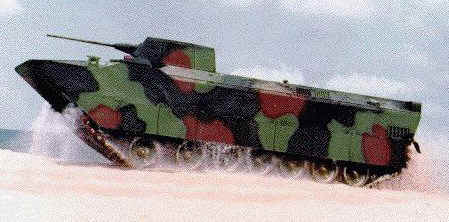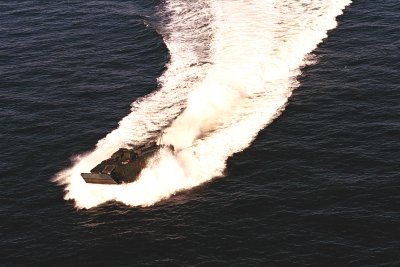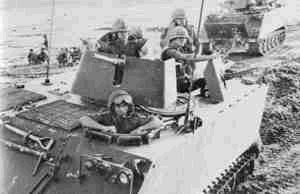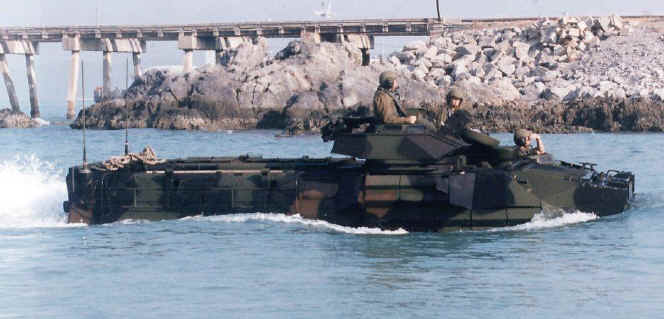Over the next decade, the US Marine Corps plans to spend most of its funding for new ground combat systems on buying 1013 Advanced Amphibious Assault Vehicles (AAAV), commonly called the amtrack. For the past several years, the Corps has spent most of its funding for all ground combat weaponry just to develop the AAAV. They will replace amtracks the Corps bought in the 1970s, which have been rebuilt and upgraded twice. The new AAAV (below) promises to be faster and more heavily armed. It has been deemed essential to future amphibious operations because it will achieve ocean speeds of 20 knots, allowing it to swoop in from ships 25 miles offshore as part of the Corps new, and irrational, doctrine of: "Operational Maneuver From The Sea (OMFTS)."
 First, read this outstanding overview from
a Marine Corps officer published at the Defense and National Interest website.
First, read this outstanding overview from
a Marine Corps officer published at the Defense and National Interest website.
Advanced Amphibious Assault Vehicle: Cold-War Dinosaur or Techno Revolution for the 21st Century?
I'd like to expand and highlight several major problems with the AAAV addressed in the article and explain why the entire program should be scrapped.
#1 The Marine Corps understands the need to lighten its logistical footprint. However, the AAAV is longer and will weigh 10 tons more than the current AAV-P7A1 (below); so fewer can be carried aboard each ship. It requires a powerful tank engine for high water speeds that burns twice as much fuel per mile. The Marine Corps has a stated goal of lightening its logistical "footprint" due to a lack of amphibious ships, and since fuel accounts for half the logistical tonnage for a Marine force, the AAAV is a leap in the wrong direction. In addition, the current amtrack can carry twice as much cargo as the new AAAV, and more troops. It can also travel just as fast on land "to keep up with tanks"; one of the false selling points for the AAAV. Finally, the current amtrack has a range of 45 miles over the ocean, making "over-the-horizon" attacks possible from 25 miles offshore, if such a need ever arises.
 #2 To
achieve high speeds, the AAAV has a complex retractable
track system to reduce drag while in the water. Suspension systems for
armored vehicles suffer tremendous strains over the years, and there is little
doubt this system will prove expensive to build and maintain. It requires
large metal flaps to cover the tracks, which are useless ashore and become
unneeded deadweight. The AAAV development program was recently extended for a year because of serious problems
with hydraulic and electronic systems, and a recent Marine Corps status report
noted:
#2 To
achieve high speeds, the AAAV has a complex retractable
track system to reduce drag while in the water. Suspension systems for
armored vehicles suffer tremendous strains over the years, and there is little
doubt this system will prove expensive to build and maintain. It requires
large metal flaps to cover the tracks, which are useless ashore and become
unneeded deadweight. The AAAV development program was recently extended for a year because of serious problems
with hydraulic and electronic systems, and a recent Marine Corps status report
noted:
"Recent experience with the prototypes indicates that their reliability is well below what is required".
#3 The AAAV has aluminum armor to reduce weight and to prevent rust. Aluminum is flammable, which is why combat ships and few "armored" vehicles use aluminum. It burns intensely, is impossible to extinguish, and produces toxic fumes, which is why it is a prime component in rocket fuel. This is particularly deadly in a waterborne amtrack since it cannot drop its rear ramp in the water to allow a quick evacuation. (The current amtrack also has flammable aluminum armor.) This is why the Marine chose steel for its fleet of Light Armored Vehicles, and why the newer US Army Bradley's use all steel. While the AAAV will include an exterior layer of composite armor and an interior "spall liner", this will not prevent the AAAV from igniting when hit by shaped explosive charges which burn through armor, like the simple Russian RPG.
#4 The Department of Defense projects each AAAV will cost $7 million each,
compared to $3 million for each M1A1 heavy tank a few years ago. This assumes the Corps
purchases all 1013 AAAV planned and that current costs do not
rise, like they always do.  The Marine Corps has nine active duty and two reserve amtrack companies with
50 amtracks per company. This is total operational requirement for only
550 amtracks (11x 50 = 550). Even allowing 50 for training and spares and
150 for pre-positioned ships,
the Corps needs no more than 750 AAAVs. The Corps has only 680
Amtracks in service today, so the "requirement" 1013 AAAVs is
the old game of overestimating to provide a cushion to cut in the
future.
The Marine Corps has nine active duty and two reserve amtrack companies with
50 amtracks per company. This is total operational requirement for only
550 amtracks (11x 50 = 550). Even allowing 50 for training and spares and
150 for pre-positioned ships,
the Corps needs no more than 750 AAAVs. The Corps has only 680
Amtracks in service today, so the "requirement" 1013 AAAVs is
the old game of overestimating to provide a cushion to cut in the
future.
This game will begin after the AAAV is approved for full production. General Dynamics will quickly raise the unit cost while the Corps tells Congress not to worry because it can make do with 750 AAAVs, so it will cost taxpayers no extra money. Based on the complexity of this vehicle and General Dynamics' record of huge price increases, I predict an average unit cost of $10 million for each AAAV in FY2002 dollars.
#5 The AAAVs only significant advantage over the current amtrack is high water speed. The AAAV cannot achieve high speeds in rough seas, and when it can "skim" the water at high speeds, it generates a huge wake visible for many miles (above), even at night. In addition, cleared mine lanes are usually very narrow, so AAAVs at high speeds are more likely to go outside lanes and hit mines. Even without mines, coastal areas are filled with coral reefs, sand bars, and rocks hidden just below the surface. An amtrack hitting an obstacle at 8 knots may cause damage and bruises, but the tracks absorb most of the impact and often help crawl over the obstacle. An AAAV hitting something at 20 knots with its tracks retracted will send it tumbling, killing or injuring everyone inside.
In short, the General Dynamics AAAV offers an extremely expensive and complex vehicle which can go twice as fast in the water, but one which weighs 10 tons more, burns twice as much fuel, and carries less cargo. It will have a larger 30mm gun, but a larger gun and turret can be added to the current amtrack. The other AAAV selling points are simply not true; it is not faster on land, it does not have greater armor protection, and it is not "essential for future amphibious operations" since the current amtrack has the range to come from ships "over the horizon". Moreover, the Navy lacks to ships to embark even half the planned AAAV fleet, and many are to be placed on pre-positioned cargo ships to be landed at ports and employed solely as Infantry Fighting Vehicles. Finally, a new type of landing ship, the LSB, can replace the need for most amtracks.
Fixing the AAAV Program
Most of the complexity and cost of the AAAV comes from the requirement to travel at 20 knots from ships to shore. If this was lowered to 8 knots, the AAAV could cost half as much and prove twice as reliable. It could weigh several tons less, carry more cargo, and burn half as much fuel. If higher water speeds are truly needed, special mounts could allow inexpensive commercial outboard motors to be added when needed to increase speed by several knots. Another option for long-range missions is for 40 knot LCACs to ferry amtracks to within a couple miles of the dangerous shoreline.
The AAAV should also adopt a safe steel hull, sealed with composite armor to prevent rust, and a tank roof is needed to defeat top-attack munitions. Designers should also look at options to reduce infrared signature. This can be done with a hybrid diesel-electric engine, or perhaps venting exhaust underwater.
Amtrack units need greater firepower, so a light
tank AAAV variant is needed; a Light Amphibious Tank (LAT). The LAT would be
identical to the AAAV except for two Hellfire missiles mounted on each side of the turret,
like the Bradley TOW mounts (above). A laser designator mounted co-axial to
the stabilized gun would allow an LAT to destroy heavy tanks and large concrete
bunkers at 5000 meters. Two 70mm rocket pods mounted on top of the turret
would allow an LAT to pulverize an area target with 38 70mm rockets within seconds.
Two M240 7.62mm machine guns could be mounted on each side protected by gun shields, similar to the M113 ACAV (right) concept used in Vietnam. Of course the machine gunners must duck inside whenever the rockets or missiles are to be fired. The two machine gunners can reload the Hellfire and rocket tubes with extra ammunition from armored boxes inside the LAT. The LAT will lead AAAVs ashore so they can employ their firepower, and draw enemy fire away from AAAVs crammed with Marines. LATs could also conduct coastal raids and serve as river gunboats.
Cancel the AAAV
In an honest world, the Marine Corps could work with General Dynamics to make these changes. In reality, the US military procurement system has become so corrupted that it will be politically impossible to force the General Dynamics machine to slashed their massive multi-billion dollar development team, or lower the unit price. They even have former Marine Corps Commandant Carl Mundy on their board of directors. They will insist on billions of dollars over the next few years to "develop" these simple modifications and will constantly evade the price issue to preserve their planned profits. Therefore, the best option is to cancel the AAAV outright and start over with new requirements for a modest AAAV open to several bidders.
However, the cost will not be justifiable unless the Marines can get the US Army and other nations to join for a contract of around 3000 vehicles (750 for the Marines, 1500 for the Army, and 500 overseas). The Marine Corps must convince the Army that it desperately needs fully amphibious vehicles. The Army conducted more large amphibious operations than the Marine Corps during World War II, but has forgotten that after 50 years of defensive strategy. The Army's mighty armored forces cannot cross water and can be easily thwarted by destroying bridges, or focusing defenses around them. Most bridges around the world cannot support an M1 heavy tank, and many cannot support the Bradley. Armored vehicles are also easily blocked in mountainous areas, except for amtracks which can cruise up rivers or along the coast to bypass obstacles. Moreover, the Army has nothing to cross rivers, except to put infantrymen in boats and tell them to paddle across like the 101st Airborne did in World War II. The Army must also discover a nifty tactic of send amtracks through "impassible" swampland to surprise an enemy. Finally, the Army must learn "amphibious envelopment" by sending amtracks out to sea or into a lake or large river to outflank an enemy.

The Army should establish an amphibious battalion in each of its six heavy divisions, or maybe one company per brigade. The Army can fund this by ending the ridiculously expensive Bradley upgrade program or the LAV "interim" swindle. The Marine Corps must make it clear that it will not proceed with development until the Army is "onboard" so that contractors will exert their influence to help the Army see the light. Since no other country makes amtracks, foreign sales are assured if the price is reasonable.
If the Marine Corps cannot sign up the Army to provide a larger customer base, the costs may remain outrageous and the Corps should invest funds in other weaponry that can really make a difference. The Marines can simply plan for another overhaul/upgrade program for its current fleet of amtracks around 2010 and revisit the AAAV need in 2015. Meanwhile, it can convert some current amtracks to LATs by mounting two 70mm rocket pods on the turret and adding M240 7.62mm machine guns on each side. Another 7.62 machine gun could be mounted for the left forward hatch, and anti-tank men with new shoulder-fired Predators can be added if tanks are expected. Simple mounts for outboard motors can be used to boost water speed, and long-range missions launched from LCACs can be practiced.
Overall, the current AAAV program is a sad joke which will rob the Marine Corps of almost all funds for equipment over the next ten years to provide a complex monster of questionable value. If the Corps were to purchase the AAAV, its vaunted high water speed may never be used in real combat during its entire service life as it struggles on shore with a huge engine and complex track system. The AAAV will fail to provide anything the Marine Corps truly needs and should be canceled today.
Carlton Meyer editorG2mil@Gmail.com
©2002 www.G2mil.com
2006 Update
From
Inside The Pentagon, June 15, 2006: Page 7 of 20:
Critical
Intelligence
MARINES PLAN HUGE PRODUCTION CUT FOR EXPEDITIONARY FIGHTING VEHICLE:
The
Marine
A
report released last month by the Government Accountability Office, the
investigative arm of Congress, noted overall costs for the program have risen 45
percent since 2000.